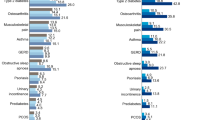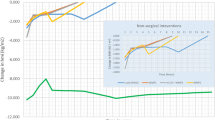Abstract
Background:
Previous studies, based on relative risks for certain secondary diseases, have shown greater healthcare costs in higher body mass index (BMI) categories. The present study quantifies the relationship between BMI and total healthcare expenditure, with the patient as the unit of analysis.
Methods:
Analyses of cross-sectional data, collected over 18-months in 2002–2003, from 3324 randomly selected patients, in 65 general practices across UK. Healthcare costs estimated from primary care, outpatient, accident/emergency and hospitalisation attendances, weighted by unit costs taken from standard sources.
Results:
In univariate analyses, significant associations (P<0.05) were found between total healthcare expenditure and all dependent variables (women>men, drinker<non-drinkers, smokers>non-smokers, and increasing with greater physical activity, age and BMI. In multivariate analysis, age, sex, BMI, smoking and alcohol consumption remained significantly associated with healthcare cost, and together explained just 9% of the variance in healthcare expenditure. Adjusted total annual healthcare cost was £16 (95% CI £11–£21) higher per unit BMI. All cost categories were significantly (P<0.003) higher for those with BMI >40 compared with BMI <20 kg m−2: prescription drugs (men: £390 versus £16; women: £211 versus £73), hospitalisation (men: £72 versus £0; women: £243 versus £107), primary care (men: £191 versus £69; women: £268 versus £153) and outpatient care (£234 versus £107 women only).
Conclusions:
Annual healthcare expenditure rose a mean of £16 per unit greater BMI, doubling between BMI 20–40 kg m−2. This gradient may be an underestimate if the lower-BMI patients with heights and weights recorded had other costly diseases.
This is a preview of subscription content, access via your institution
Access options
Subscribe to this journal
Receive 12 print issues and online access
$259.00 per year
only $21.58 per issue
Buy this article
- Purchase on Springer Link
- Instant access to full article PDF
Prices may be subject to local taxes which are calculated during checkout


Similar content being viewed by others
References
World Health Organization (WHO). Obesity and Overweight. Geneva, 2006. Available online http://www.who.int/dietphysicalactivity/publications/facts/obesity/en/ (accessed May 2012).
Scottish Health Survey 2008. The Scottish Government ISBN 9780755981076 UK, 2009. Available online at http://www.scotland.gov.uk/Publications/2009/09/28102003/76 (accessed May 2012).
Bray GA . Pathophysiology of obesity. AJCN 1992; 55: 488S–494S.
Counterweight Project Team. Influence of body mass index on prescribing costs and potential cost savings of a weight management programme in primary care. J Health Ser Res Policy 2008; 13: 158–166.
HMSO Summary of the House of Commons Health Committee report on Obesity 2004. Available online at http://www.parliament.the-stationery-office.co.uk/cmhealth.htm (accessed May 2012).
Birmingham CL, Muller JL, Palepu A, Spinelli JJ, Anis AH . The cost of obesity in Canada. Can Med Assoc J 1999; 160: 483–488.
Katzmarzyk PT, Janssen I . The economic costs associated with physical inactivity and obesity in Canada: an update. Can J Appl Physio 2004; 29: 90–115.
Wolf AM, Finer N, Allshouse AA, Pendergast KB, Sherrill BH, Caterson I et al. PROCEED: prospective obesity cohort of economic evaluation and determinants: baseline health and healthcare utilization of the US sample. Diab Obes Metabol 2008; 10: 1248–1260.
Quesenberry CP, Caan B, Jacobson A . Obesity, health services use, and healthcare costs among members of a health maintenance organization. Archive Internal Med 1998; 158: 466–472.
Finkelstein MM . Obesity, cigarette smoking and the cost of physicians' services in Ontario. Can J Public Health 2001; 92: 437–440.
Sturm R . The effects of obesity, smoking, and drinking on medical problems and costs. Health Affilates 2002; 21: 245–253.
Raebel MA, Malone DC, Conner DA, Xu S, Porter JA, Lanty FA . Health services use and healthcare costs of obese and nonobese individuals. Archives Internal Med 2004; 164: 2135–2140.
Mueller-Riemenschneider F, Reinhold T, Berghofer A, Willich SN . Health-economic burden of obesity in Europe. Eur J Epidem 2008; 23: 499–509.
Han E, Truesdale KP, Taber DR, Cai J, Juhaeri J, Stevens J . Impact of overweight and obesity on hospitalization: race and gender differences. Int J Obes 2009; 33: 249–256.
Borg S, Persson U, Odegaard K, Berglund G, Nilsson JA, Nilsson PM . Obesity, survival, and hospital costs—Findings from a screening project in Sweden. Value Health 2005; 8: 562–571.
Sichieri R, do Nascimento S, Coutinho W . The burden of hospitalization due to overweight and obesity in Brazil. Cad Saude Publica 2007; 23: 1721–1727.
Long DA, Reed R, Lehman G . The cost of lifestyle health risks: obesity. J Occup Environ Med 2006; 48: 244–251.
Heithoff KA, Cuffel BJ, Kennedy S, Peters J . The association between body mass and healthcare expenditures. Clinl Therapy 1997; 19: 811–820.
Thompson D, Brown JB, Nichols GA . Body mass index and future healthcare costs: a retrospective cohort study. Obes Res 2001; 9: 210–218.
Bungum T, Satterwhite M, Jackson AW, Morrow JR . The relationship of body mass index, medical costs, and job absenteeism. Amer J Health Behav 2003; 27: 456–462.
Andreyeva T, Sturm R, Ringel JS . Moderate and severe obesity have large differences in healthcare costs. Obes Res 2004; 12: 1936–1943.
Wee CC, Phillips RS, Legedza ATR, Davis SB, Soukup JR, Colditz GA et al. Healthcare expenditures associated with overweight and obesity among US adults: importance of age and race. Amer J Public Health 2005; 95: 1159–1165.
von Lengerke T, Reitmeir P, John J . Direct medical costs of (severe) obesity: a bottom-up assessment of over- vs normal-weight adults in the KORA-study region (Augsburg, Germany)]. Gesundheitswesen 2006; 68: 110–115.
Valderrama A, Lawrence L . Association between BMI and healthcare expenditures using the 2002 medical expenditure panel survey. Value Health 2006; 9: A89–A90.
Wang F, McDonald T, Bender J, Reffitt B, Miller A, Edington D . Association of healthcare costs with per unit body mass index increase. J Occup Environ Med 2006; 48: 668–674.
Rappange DR, Brouwer WBF, Hoogenveen RT, van Baal PHM . Healthcare costs and obesity prevention: drug costs and other sector-specific consequences. Pharmacoeconomics 2009; 27: 1031–1044.
Counterweight Project Team. A new evidence-based model for weight management in primary care: the counterweight programme. J HumNutr Diet 2004; 17: 191–208.
Curtis L . Unit Costs of Health and Social Care. Personal Social Services Research Unit Report. University of Kent: Canterbury, 2009.
Rehm J, Greenfield TK, Rogers JD . Average volume of alcohol consumption, patterns of drinking, and all-cause mortality: results from the us national alcohol survey. Amer J Epidem 2001; 153: 64–71.
Worsley A, Baghurst KI, Leich DR . Social desirability response bias and dietary inventory responses. Hum Nutr App Nutr 1984; 38: 29–35.
Acknowledgements
We thank all members of the Counterweight Team for providing access to the data and for advice during the analyses. The study was funded by the UK Counterweight Project and the University of Glasgow.
Author information
Authors and Affiliations
Corresponding author
Ethics declarations
Competing interests
The authors declare no conflict of interest.
Additional information
Supplementary Information accompanies the paper on International Journal of Obesity website
Supplementary information
Rights and permissions
About this article
Cite this article
Tigbe, W., Briggs, A. & Lean, M. A patient-centred approach to estimate total annual healthcare cost by body mass index in the UK Counterweight programme. Int J Obes 37, 1135–1139 (2013). https://doi.org/10.1038/ijo.2012.186
Received:
Revised:
Accepted:
Published:
Issue Date:
DOI: https://doi.org/10.1038/ijo.2012.186
Keywords
This article is cited by
-
Real-world costs of obesity-related complications over eight years: a US retrospective cohort study in 28,500 individuals
International Journal of Obesity (2023)
-
Mendelian randomization: estimation of inpatient hospital costs attributable to obesity
Health Economics Review (2021)
-
Body mass index and use and costs of primary care services among women aged 55–79 years in England: a cohort and linked data study
International Journal of Obesity (2019)
-
Diet-induced obesity causes hypothalamic neurochemistry alterations in Swiss mice
Metabolic Brain Disease (2019)
-
Long-term weight loss trajectories following participation in a randomised controlled trial of a weight management programme for men delivered through professional football clubs: a longitudinal cohort study and economic evaluation
International Journal of Behavioral Nutrition and Physical Activity (2018)



